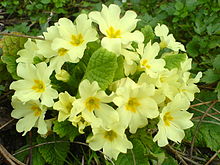Primula vulgaris
| Primula vulgaris | |
|---|---|

| |
| Scientific classification | |
| Kingdom: | |
| (unranked): | |
| (unranked): | |
| (unranked): | |
| Order: | |
| Family: | |
| Genus: | |
| Species: | P. vulgaris
|
| Binomial name | |
| Primula vulgaris | |
Primula vulgaris (syn. P. acaulis (L.) Hill) is a species of Primula native to western and southern Europe (from the Faroe Islands and Norway south to Portugal, and east to Germany, Ukraine, the Crimea, and the Balkans), northwest Africa (Algeria), and southwest Asia (Turkey east to Iran).[1][2] The common name is primrose,[3] or occasionally common primrose or English primrose to distinguish it from other Primula species also called primroses.

It is a herbaceous perennial plant, low growing, to 10–30 cm tall, with a basal rosette of leaves. The leaves are 5–25 cm long and 2–6 cm broad with an irregularly crenate to dentate margin, and a usually short leaf stem. The flowers are 2–4 cm in diameter, borne singly on a slender stem, pale yellow, white, red, or purple (see further below), actinomorphic with a superior ovary which later forms a capsule which opens by valves to release the small black seeds. The flowers are hermaphrodite but heterostylous; individual plants bear either pin flowers (with the capita of the style prominent) or thrum flowers (with the stamens prominent). Fertilisation can only take place between pin and thrum flowers. Pin-to-pin and thrum-to-thrum pollination is ineffective.[4][5]

It flowers in early spring, one of the earliest spring flowers in much of Europe. ("Primrose" is ultimately from Old French primerose or medieval Latin prima rosa, meaning first "rose".[6]) In appropriate conditions, it can cover the ground in open woods and shaded hedgerows.
In more populated areas it has sometimes suffered from over-collection and theft so that few natural displays of primroses in abundance can now be found. To prevent excessive damage to the species, picking of primroses or the removal of primrose plants from the wild is illegal in many countries, e.g. the UK (Wildlife and Countryside Act 1981, Section 13, part 1b).
The wild primrose was also once a common sight in Victorian cottage gardens. Many garden centres now stock the wild variety for those gardeners who are keen on wildflowers.
There are three subspecies:[1][5]
- Primula vulgaris subspecies vulgaris. Western and southern Europe. As described above; flowers pale yellow.
- Primula vulgaris subsp. balearica (Willk.) W.W.Sm. & Forrest. Balearic Islands (endemic). Flowers white. Leaf stem longer than leaf blade.
- Primula vulgaris subsp. sibthorpii (Hoffmanns.) W.W.Sm. & Forrest. Balkans, southwest Asia. Flowers pink to red or purple.
It is distinguished from other species of Primula by its pale yellow (in the nominate subspecies) flowers produced singly on long flower stalks which are covered in rather shaggy hairs. The flowers open flat rather than concave as in the case of Primula veris, the Cowslip.
Cultivation and uses
Numerous cultivars have been selected for garden planting, often derived from subsp. sibthorpii or hybrids between the subspecies; these and other garden hybrids are available in a wide range of colours and with an extended flowering season.[5] Pink and red flowered primroses growing in natural conditions in western Europe are usually naturalised from garden escapes,[4] though a pink-flowered form is reported locally as a wild plant in Wales.[7] Both flowers and leaves are edible, the flavour ranging between mild lettuce and more bitter salad greens. The leaves can also be used for tea, and the young flowers can be made into primrose wine.
In culture
The primrose was Benjamin Disraeli's favourite flower, and the Primrose League was given its name in honour of this.
References
- ^ a b Flora Europaea: Primula vulgaris
- ^ Germplasm Resources Information Network: Primula vulgaris
- ^ Natural History Museum: Primula vulgaris
- ^ a b Blamey, M. & Grey-Wilson, C. (1989). Flora of Britain and Northern Europe. ISBN 0-340-40170-2
- ^ a b c Huxley, A, ed. (1992). New RHS Dictionary of Gardening. ISBN 0-333-47494-5
- ^ New Shorter Oxford English Dictionary, 1993
- ^ Clapham, A., Tutin, T., & Warburg, E. (1962). Flora of the Brish Isles.
